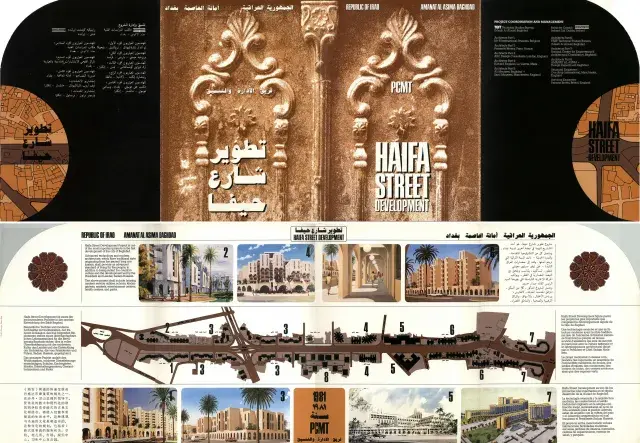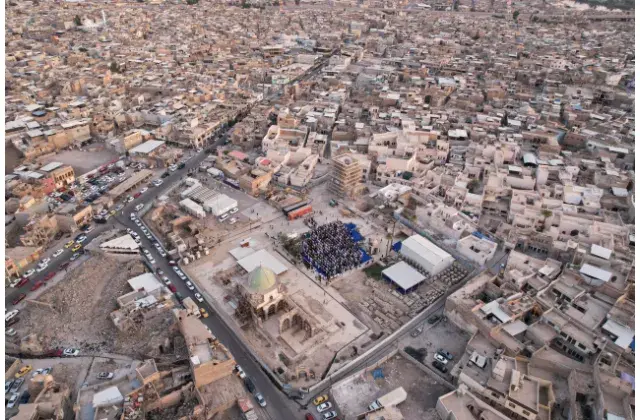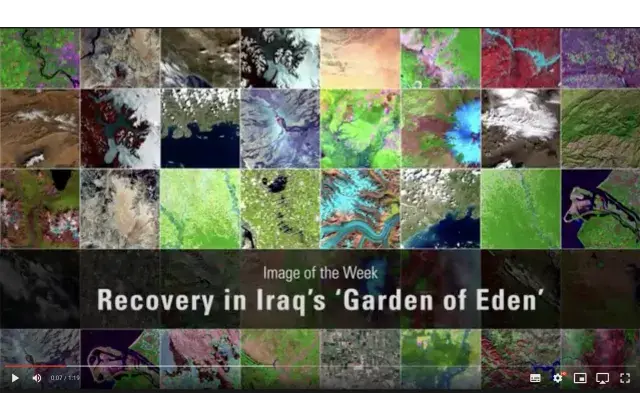هاوتەریب لەگەڵ شەڕی ئێران و عێراق - دیمەنی شاری بەغدا گۆڕا (١٩٧٩ - ١٩٩٠)

سەددام حوسێن بۆ ئامادەکردنی دیکتاتۆریەتی خۆی، نزیکەی دە ساڵی پێویست بوو. پێشتر دەزگایەکی لە دەوری خۆی ئامادە کردبوو کە پارتی بەعس و ئەنجومەنی فەرماندەیی شۆڕش توانای بڕیاردانی ئازادیان لەدەستداوە. لایەنگرە کەسییەکانی کە لە ڕێگای میدیای حزبییەوە بانگەشەی بۆ دەکرا، ڕایگەیاند: "لە دوای پاشاکانی سۆمەرییەوە، هێڵێکی ڕاست هەبووە کە بەرەو سەددام حوسێن دەڕوات و عێراق سەرکردەی سروشتی هەموو عەرەبەکانە". لە کاتێکدا ئەمە شێواندنی تەواوی مێژوو بوو، بەڵام ئەوە نیشانەی تێڕوانینەکانی سیاسەتی ناوخۆیی و دەرەوەی ئەو بوو. سەددام نەک هەر ئامانجی بەڕێوەبردنی عێراق بوو، بەڵکو خۆی وەک ‘سەرکردەی شیاوی’ جیهانی ئیسلامی دەبینی. سەددام حوسێن پەیوەندییەکی پتەوی لەگەڵ سەرکردەکانی وەک فیدڵ کاسترۆی کوبا هەبوو، کە تایبەتمەند بوو بە پاڵپشتی و هاوکاری یەکتر، بەتایبەتی لە بواری چاودێری تەندروستی و هاوپەیمانی سیاسی. کوبا لە ساڵی ١٩٧٩ میوانداری شەشەمین لوتکەی بزووتنەوەی بێ لایەنەکانی کرد، کە کۆڕبەندی ١٢٠ وڵات بوو. وڵاتی میوانداری لوتکەکە بە شێوەیەکی ئۆتۆماتیکی تا لوتکەی داهاتوو پۆستی سەرۆکایەتیی بەدەستەوەبوو. فیدڵ کاسترۆ وەڵامی خێرای دایەوە بۆ میوانداریکردنی لوتکەی داهاتووی ساڵی ١٩٨٣ لە بەغدا. بەڵێنیدا حەوتەمین لوتکەی بێلایەنەکان کارێکی شکۆدار بێت. لیستی میوانەکان بە مەزەندەکردن لە ٣ هەزار کەس پێکهاتبوو، لە ٩٥ وڵاتەوە کە بە لایەنیکەم ٩٠ سەرۆکی دەوڵەتیان تێدابوو. لە سەروویەوە سەددام ڕۆڵی باڵادەستی لە داڕشتن و ستراتیژی بزووتنەوەکەدا هەبوو، تا لوتکەی داهاتوو لە ساڵی ١٩٨٥. تەنها شەش مانگ پێش لوتکەکە، شوێنەکەی لە بەغداوە گواسترایەوە بۆ نیودەلهی، بەهۆی شەڕی ئێران و عێراقەوە (١٩٨٠-١٩٨٨).
.
بۆ ئامادەکردنی لوتکەکە، سەددام پڕۆژەی بیناسازی بەرفراوان و هێمایی لە بەغدا ڕاسپارد، کە بریتیبوون لە ژێرخانی گەشتیاری و ڕۆشنبیری: شانۆی نیشتمانی (١٩٧٩)، هۆڵی وەرزشی بەغدا، هۆڵی وەرزشی پێشووی سەددام حوسێن، لەسەر بنەمای دیزاینێکی لو کۆربوزێە ( ١٩٨٠)، شانۆی ئەل ڕەشید (١٩٨١)، کۆشکی کۆنفڕانسی بەغدا (١٩٨٢)، هۆتێل ئەل مەنسور مێلیا (١٩٨٠)، هۆتێل ئەل ڕەشید (١٩٨٢)، هۆتێلی عەشتار و فەلەستین (١٩٨٢)، و هۆتێل بابل (١٩٨٤). یەکێک لە گرنگترین پڕۆژە گرنگەکانی سەددام، پلانی گەشەپێدانی شەقامی حەیفا بوو. شەقامەکە بە ناوی شاری بەندەری باکووری فەلەستین "حەیفا" ناونرا. پلانەکە بریتی بوو لە پڕۆژەی نیشتەجێبوون، خزمەتگوزارییە هاوچەرخەکان، قوتابخانە، باخچەی ساوایان، بازاڕ، سەنتەری کات بەسەربردن، بنکە تەندروستییەکان و پارکەکان. هەموو ئەم کارە بیناسازییانە لەلایەن 'کۆمەڵ'ێکەوە ئەنجامدران کە پێکهاتبوون لە تەلارسازە پێشەنگەکانی عێراق و کۆمپانیا نێودەوڵەتییەکان.
پارتی بەعس ئێستا ڕێکخراوێکی سەرتاسەری وڵات بوو کە دەستی دەگەیشتە بچووکترین گوند. سەددام تۆڕی ئاڵۆزی ڕاژەخوازی سپۆنسەرکراوی دروستکرد کە خەڵکیان بە زۆرەملێ و خۆپەسەندکرن بە خۆیانەوە بەستەوە. بەڵام هەموویان دوای سەددام نەکەوتن. لە ناوەڕاستی هەشتاکانی سەدەی ڕابردوودا، ڕەنگە نیو ملیۆن پیشەیی و ڕۆشنبیری عێراقی وڵاتیان بەجێهێشتبێت. بۆ ئەو 'شوێنکەوتووانەی' کە مابوونەوە، جۆرێک لە هەستی متمانەی بۆ دابینکردن لە ڕێگای فێستیڤاڵە کولتوورییەکانی وەک فێستیڤاڵی ئەدەبی ئەل میرباد لە بەسرە کە لە ساڵی ١٩٨١ دەستی پێکرد و فێستیڤاڵی نێودەوڵەتی بابل کە بۆ یەکەمجار لە ساڵی ١٩٨٨ بەڕێوەچوو.
لە ساڵی ١٩٧٩، بەغدا میوانداری پێنجەمین جامی کەنداوی عەرەبی کرد لە یاریگای شەعب، کە لەلایەن دامەزراوەی گوڵبێنکیانەوە لە نێوان ساڵانی ١٩٦٣ بۆ ١٩٦٦ دروستکرابوو، هەڵبژاردەی تۆپی پێی عێراق نازناوەکەی بەدەستهێنا، کە یەکەم نازناوی خۆی بوو. جامەکە لە سەرەتادا بڕیاربوو لە ساڵی ١٩٧٨ لە ئەبوزەبی بەڕێوەبچێت، بەڵام کاتێک ئیمارات دەستبەرداری مافی میوانداریکردنی بوو، سەددام زۆر حەزی دەکرد عێراق میوانداری پاڵەوانێتییەکە بکات. هەشتاکانی سەدەی ڕابردوو قۆناغێکی سەرکەوتن بوو بۆ تۆپی پێی عێراق بە گشتی. جگە لە بردنەوەی جامی کەنداوی عەرەبی لە ساڵانی ١٩٨٤ و ١٩٨٨، چەندین پاڵەوانێتییان بەدەستهێنا، لەوانە یارییەکانی ئاسیای ١٩٨٢ و جامی عەرەبی ١٩٨٥ و ١٩٨٨ و یارییەکانی پان عەرەب ساڵی ١٩٨٥.
.
لە ساڵی ١٩٨٤ سەددام حوسێن، عودەی کوڕی خۆی بە سەرۆکی لیژنەی ئۆڵۆمپی عێراق و یەکێتی تۆپی پێی عێراق دەستنیشان کرد. عودەی حوسێن کەسێکی پێشبینی نەکراو و بێ بەزەیی بوو، بۆ نموونە بە ئەشکەنجەدان و زیندانیکردنی وەرزشوانان و ڕاهێنەرەکان، لە زیندانە تایبەتیەکەی لە بینای کۆمیتەی ئۆڵۆمپیدا ناسرابوو کاتێک نەیانتوانی خەڵات و جامەکان بهێننەوە ماڵەوە. لە ئەنجامدا زۆرێک لە وەرزشوانان وڵاتیان بەجێهێشت.
هەرچەندە وڵات لە سەردەمی جەنگی ئێران و عێراقدا لە پاڵەوانێتییەکەیدا بوو، بەڵام سەددام مۆنۆمێنتی گەورەی دروستکرد کە سەرکەوتن و دەسەڵاتی خۆی شکۆمەند کرد. ئەم پڕۆژانە بە شێوەیەکی سەرەکی پێش شەڕی ئێران و عێراق پلانیان بۆ دانرابوو، کە سەددام وەک شەڕێکی تروسکەئاسا پێشبینی دەکرد. سەرەڕای ئەوەش، شەڕەکە بە شێوەیەکی سەرەکی لە دەوروبەری سنوورەکانی ئەو دوو وڵاتەدا ئەنجامدرا. سەددام هەوڵیدا بەغدا لە ناوچەی شەڕ دوور بخاتەوە. یەکەم مۆنۆمێنتیش ئی سەربازە نەناسراوەکە بوو لە تەنیشت گۆڕەپانی ئاهەنگگێڕانی گەورە، لە ساڵی ١٩٧٩ دامەزرا و لە ساڵی ١٩٨٢ تەواو بوو. لە ساڵی ١٩٨١ تا ١٩٨٣ مۆنۆمێنتی شەهیدان لە شەقامی فەلەستین دروستکرا، کە یادی سەربازە کوژراوەکانی شەڕی ئێران و عێراق بوو. لە ساڵی ١٩٨٦ سەددام دەستی کرد بە دروستکردنی گۆڕەپانی ئاهەنگگێڕانی گەورە، کە پێکهاتبوو لە گۆڕەپانێکی گەورەی نمایش و کۆمەڵگای بینای مەنسور لە بەشی باکوور کە پێکهاتبوو لە سینەما مەنسور، گەلەری ئایکیدۆ و شانۆی مەنسور. سەددام گەیشتە لوتکەی شکۆمەندی، لە کاتی کردنەوەی تاقی سەرکەوتنی قادیسییەی هێمادار لە ساڵی ١٩٨٩، کە پەیکەرێکی کانزایی گەورە بوو، پێکهاتبوو لە دوو شمشێری تێکگیراو و بە دەستی زەبەلاحی برۆنزی بەرز ڕاگیراون، کە بەرزییەکەی دەگاتە خانووێک، لەسەر شێوەی دەستەکانی سەددام، ئەم تاقە دەکەوێتە هەردوو دەروازەی گۆڕەپانی ئاهەنگگێڕانی گەورە.
هذا المحتوى مرخص بموجب رخصة المشاع الإبداعي CC BY-NC 4.0.






